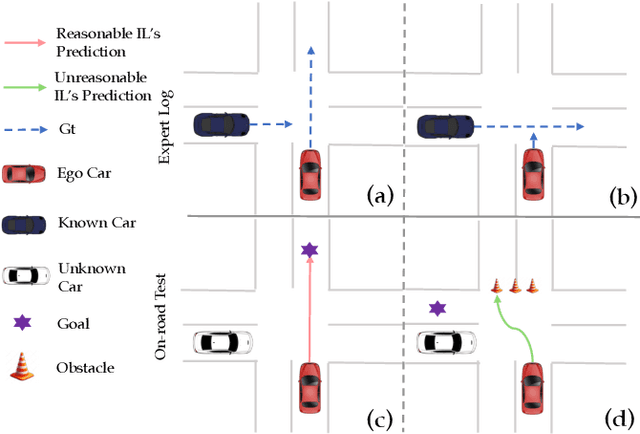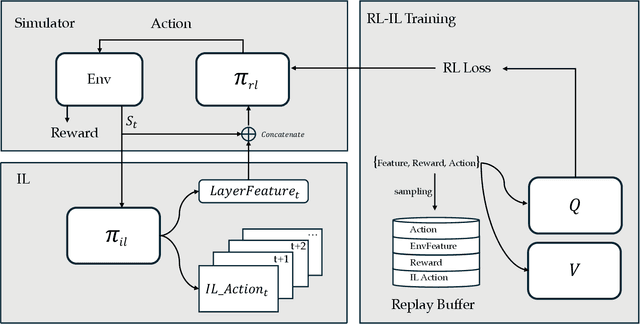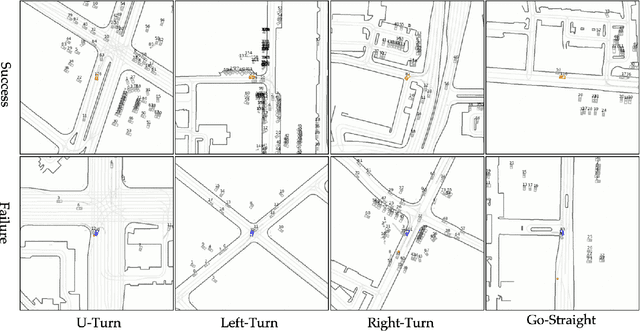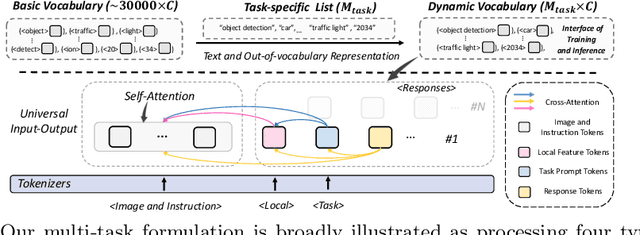Shaoshuai Shi
Foresight in Motion: Reinforcing Trajectory Prediction with Reward Heuristics
Jul 16, 2025



Abstract:Motion forecasting for on-road traffic agents presents both a significant challenge and a critical necessity for ensuring safety in autonomous driving systems. In contrast to most existing data-driven approaches that directly predict future trajectories, we rethink this task from a planning perspective, advocating a "First Reasoning, Then Forecasting" strategy that explicitly incorporates behavior intentions as spatial guidance for trajectory prediction. To achieve this, we introduce an interpretable, reward-driven intention reasoner grounded in a novel query-centric Inverse Reinforcement Learning (IRL) scheme. Our method first encodes traffic agents and scene elements into a unified vectorized representation, then aggregates contextual features through a query-centric paradigm. This enables the derivation of a reward distribution, a compact yet informative representation of the target agent's behavior within the given scene context via IRL. Guided by this reward heuristic, we perform policy rollouts to reason about multiple plausible intentions, providing valuable priors for subsequent trajectory generation. Finally, we develop a hierarchical DETR-like decoder integrated with bidirectional selective state space models to produce accurate future trajectories along with their associated probabilities. Extensive experiments on the large-scale Argoverse and nuScenes motion forecasting datasets demonstrate that our approach significantly enhances trajectory prediction confidence, achieving highly competitive performance relative to state-of-the-art methods.
Edit360: 2D Image Edits to 3D Assets from Any Angle
Jun 12, 2025Abstract:Recent advances in diffusion models have significantly improved image generation and editing, but extending these capabilities to 3D assets remains challenging, especially for fine-grained edits that require multi-view consistency. Existing methods typically restrict editing to predetermined viewing angles, severely limiting their flexibility and practical applications. We introduce Edit360, a tuning-free framework that extends 2D modifications to multi-view consistent 3D editing. Built upon video diffusion models, Edit360 enables user-specific editing from arbitrary viewpoints while ensuring structural coherence across all views. The framework selects anchor views for 2D modifications and propagates edits across the entire 360-degree range. To achieve this, Edit360 introduces a novel Anchor-View Editing Propagation mechanism, which effectively aligns and merges multi-view information within the latent and attention spaces of diffusion models. The resulting edited multi-view sequences facilitate the reconstruction of high-quality 3D assets, enabling customizable 3D content creation.
TrajFlow: Multi-modal Motion Prediction via Flow Matching
Jun 10, 2025Abstract:Efficient and accurate motion prediction is crucial for ensuring safety and informed decision-making in autonomous driving, particularly under dynamic real-world conditions that necessitate multi-modal forecasts. We introduce TrajFlow, a novel flow matching-based motion prediction framework that addresses the scalability and efficiency challenges of existing generative trajectory prediction methods. Unlike conventional generative approaches that employ i.i.d. sampling and require multiple inference passes to capture diverse outcomes, TrajFlow predicts multiple plausible future trajectories in a single pass, significantly reducing computational overhead while maintaining coherence across predictions. Moreover, we propose a ranking loss based on the Plackett-Luce distribution to improve uncertainty estimation of predicted trajectories. Additionally, we design a self-conditioning training technique that reuses the model's own predictions to construct noisy inputs during a second forward pass, thereby improving generalization and accelerating inference. Extensive experiments on the large-scale Waymo Open Motion Dataset (WOMD) demonstrate that TrajFlow achieves state-of-the-art performance across various key metrics, underscoring its effectiveness for safety-critical autonomous driving applications. The code and other details are available on the project website https://traj-flow.github.io/.
DriveX: Omni Scene Modeling for Learning Generalizable World Knowledge in Autonomous Driving
May 25, 2025Abstract:Data-driven learning has advanced autonomous driving, yet task-specific models struggle with out-of-distribution scenarios due to their narrow optimization objectives and reliance on costly annotated data. We present DriveX, a self-supervised world model that learns generalizable scene dynamics and holistic representations (geometric, semantic, and motion) from large-scale driving videos. DriveX introduces Omni Scene Modeling (OSM), a module that unifies multimodal supervision-3D point cloud forecasting, 2D semantic representation, and image generation-to capture comprehensive scene evolution. To simplify learning complex dynamics, we propose a decoupled latent world modeling strategy that separates world representation learning from future state decoding, augmented by dynamic-aware ray sampling to enhance motion modeling. For downstream adaptation, we design Future Spatial Attention (FSA), a unified paradigm that dynamically aggregates spatiotemporal features from DriveX's predictions to enhance task-specific inference. Extensive experiments demonstrate DriveX's effectiveness: it achieves significant improvements in 3D future point cloud prediction over prior work, while attaining state-of-the-art results on diverse tasks including occupancy prediction, flow estimation, and end-to-end driving. These results validate DriveX's capability as a general-purpose world model, paving the way for robust and unified autonomous driving frameworks.
SOLVE: Synergy of Language-Vision and End-to-End Networks for Autonomous Driving
May 22, 2025Abstract:The integration of Vision-Language Models (VLMs) into autonomous driving systems has shown promise in addressing key challenges such as learning complexity, interpretability, and common-sense reasoning. However, existing approaches often struggle with efficient integration and realtime decision-making due to computational demands. In this paper, we introduce SOLVE, an innovative framework that synergizes VLMs with end-to-end (E2E) models to enhance autonomous vehicle planning. Our approach emphasizes knowledge sharing at the feature level through a shared visual encoder, enabling comprehensive interaction between VLM and E2E components. We propose a Trajectory Chain-of-Thought (T-CoT) paradigm, which progressively refines trajectory predictions, reducing uncertainty and improving accuracy. By employing a temporal decoupling strategy, SOLVE achieves efficient cooperation by aligning high-quality VLM outputs with E2E real-time performance. Evaluated on the nuScenes dataset, our method demonstrates significant improvements in trajectory prediction accuracy, paving the way for more robust and reliable autonomous driving systems.
Exposing the Copycat Problem of Imitation-based Planner: A Novel Closed-Loop Simulator, Causal Benchmark and Joint IL-RL Baseline
Apr 20, 2025



Abstract:Machine learning (ML)-based planners have recently gained significant attention. They offer advantages over traditional optimization-based planning algorithms. These advantages include fewer manually selected parameters and faster development. Within ML-based planning, imitation learning (IL) is a common algorithm. It primarily learns driving policies directly from supervised trajectory data. While IL has demonstrated strong performance on many open-loop benchmarks, it remains challenging to determine if the learned policy truly understands fundamental driving principles, rather than simply extrapolating from the ego-vehicle's initial state. Several studies have identified this limitation and proposed algorithms to address it. However, these methods often use original datasets for evaluation. In these datasets, future trajectories are heavily dependent on initial conditions. Furthermore, IL often overfits to the most common scenarios. It struggles to generalize to rare or unseen situations. To address these challenges, this work proposes: 1) a novel closed-loop simulator supporting both imitation and reinforcement learning, 2) a causal benchmark derived from the Waymo Open Dataset to rigorously assess the impact of the copycat problem, and 3) a novel framework integrating imitation learning and reinforcement learning to overcome the limitations of purely imitative approaches. The code for this work will be released soon.
JiSAM: Alleviate Labeling Burden and Corner Case Problems in Autonomous Driving via Minimal Real-World Data
Mar 13, 2025Abstract:Deep-learning-based autonomous driving (AD) perception introduces a promising picture for safe and environment-friendly transportation. However, the over-reliance on real labeled data in LiDAR perception limits the scale of on-road attempts. 3D real world data is notoriously time-and-energy-consuming to annotate and lacks corner cases like rare traffic participants. On the contrary, in simulators like CARLA, generating labeled LiDAR point clouds with corner cases is a piece of cake. However, introducing synthetic point clouds to improve real perception is non-trivial. This stems from two challenges: 1) sample efficiency of simulation datasets 2) simulation-to-real gaps. To overcome both challenges, we propose a plug-and-play method called JiSAM , shorthand for Jittering augmentation, domain-aware backbone and memory-based Sectorized AlignMent. In extensive experiments conducted on the famous AD dataset NuScenes, we demonstrate that, with SOTA 3D object detector, JiSAM is able to utilize the simulation data and only labels on 2.5% available real data to achieve comparable performance to models trained on all real data. Additionally, JiSAM achieves more than 15 mAPs on the objects not labeled in the real training set. We will release models and codes.
AMP: Autoregressive Motion Prediction Revisited with Next Token Prediction for Autonomous Driving
Mar 21, 2024



Abstract:As an essential task in autonomous driving (AD), motion prediction aims to predict the future states of surround objects for navigation. One natural solution is to estimate the position of other agents in a step-by-step manner where each predicted time-step is conditioned on both observed time-steps and previously predicted time-steps, i.e., autoregressive prediction. Pioneering works like SocialLSTM and MFP design their decoders based on this intuition. However, almost all state-of-the-art works assume that all predicted time-steps are independent conditioned on observed time-steps, where they use a single linear layer to generate positions of all time-steps simultaneously. They dominate most motion prediction leaderboards due to the simplicity of training MLPs compared to autoregressive networks. In this paper, we introduce the GPT style next token prediction into motion forecasting. In this way, the input and output could be represented in a unified space and thus the autoregressive prediction becomes more feasible. However, different from language data which is composed of homogeneous units -words, the elements in the driving scene could have complex spatial-temporal and semantic relations. To this end, we propose to adopt three factorized attention modules with different neighbors for information aggregation and different position encoding styles to capture their relations, e.g., encoding the transformation between coordinate systems for spatial relativity while adopting RoPE for temporal relativity. Empirically, by equipping with the aforementioned tailored designs, the proposed method achieves state-of-the-art performance in the Waymo Open Motion and Waymo Interaction datasets. Notably, AMP outperforms other recent autoregressive motion prediction methods: MotionLM and StateTransformer, which demonstrates the effectiveness of the proposed designs.
GiT: Towards Generalist Vision Transformer through Universal Language Interface
Mar 14, 2024



Abstract:This paper proposes a simple, yet effective framework, called GiT, simultaneously applicable for various vision tasks only with a vanilla ViT. Motivated by the universality of the Multi-layer Transformer architecture (e.g, GPT) widely used in large language models (LLMs), we seek to broaden its scope to serve as a powerful vision foundation model (VFM). However, unlike language modeling, visual tasks typically require specific modules, such as bounding box heads for detection and pixel decoders for segmentation, greatly hindering the application of powerful multi-layer transformers in the vision domain. To solve this, we design a universal language interface that empowers the successful auto-regressive decoding to adeptly unify various visual tasks, from image-level understanding (e.g., captioning), over sparse perception (e.g., detection), to dense prediction (e.g., segmentation). Based on the above designs, the entire model is composed solely of a ViT, without any specific additions, offering a remarkable architectural simplification. GiT is a multi-task visual model, jointly trained across five representative benchmarks without task-specific fine-tuning. Interestingly, our GiT builds a new benchmark in generalist performance, and fosters mutual enhancement across tasks, leading to significant improvements compared to isolated training. This reflects a similar impact observed in LLMs. Further enriching training with 27 datasets, GiT achieves strong zero-shot results over various tasks. Due to its simple design, this paradigm holds promise for narrowing the architectural gap between vision and language. Code and models will be available at \url{https://github.com/Haiyang-W/GiT}.
UniTR: A Unified and Efficient Multi-Modal Transformer for Bird's-Eye-View Representation
Aug 15, 2023Abstract:Jointly processing information from multiple sensors is crucial to achieving accurate and robust perception for reliable autonomous driving systems. However, current 3D perception research follows a modality-specific paradigm, leading to additional computation overheads and inefficient collaboration between different sensor data. In this paper, we present an efficient multi-modal backbone for outdoor 3D perception named UniTR, which processes a variety of modalities with unified modeling and shared parameters. Unlike previous works, UniTR introduces a modality-agnostic transformer encoder to handle these view-discrepant sensor data for parallel modal-wise representation learning and automatic cross-modal interaction without additional fusion steps. More importantly, to make full use of these complementary sensor types, we present a novel multi-modal integration strategy by both considering semantic-abundant 2D perspective and geometry-aware 3D sparse neighborhood relations. UniTR is also a fundamentally task-agnostic backbone that naturally supports different 3D perception tasks. It sets a new state-of-the-art performance on the nuScenes benchmark, achieving +1.1 NDS higher for 3D object detection and +12.0 higher mIoU for BEV map segmentation with lower inference latency. Code will be available at https://github.com/Haiyang-W/UniTR .
 Add to Chrome
Add to Chrome Add to Firefox
Add to Firefox Add to Edge
Add to Edge